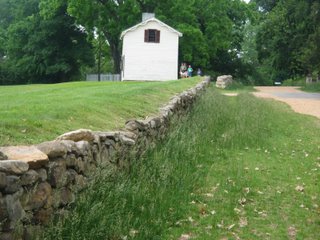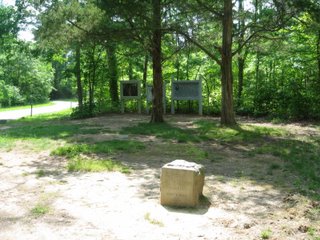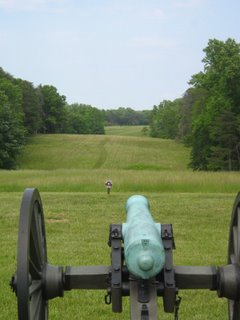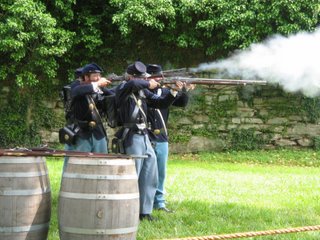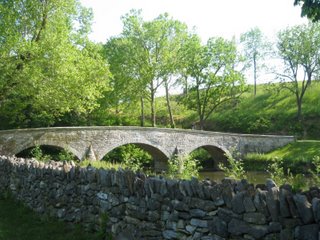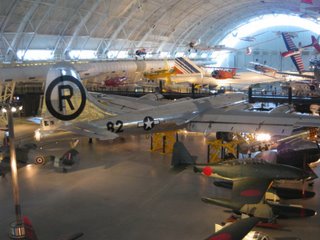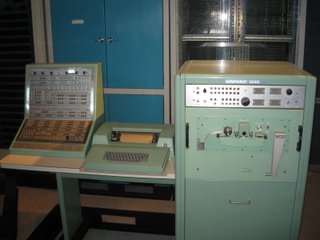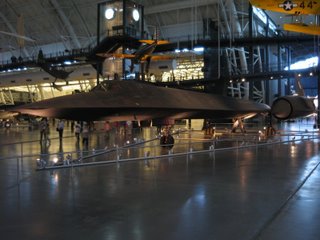And Canada's like, "What's going on eh?"
Well, since we finished up at Antietam, we've been busy travelling. For our last week before returning the mighty Kia Rio back to New York, we decided to spend four days driving up to Niagara Falls, complete a circle round Lake Ontario before returning to the US and to Gettysburg, where we'll spend three days to finish up.
It's been good. Driving first through backwoods Pennsylvania and upstate New York has given us a chance to experience some of the American countryside, and by god, it is magnificent. Massive hills and valley, covered in greenery. Rivers and creeks everywhere. Excellent quality highways to drive on (well, until you reach the Canadian border - more on that later.)
Driving in America is an interesting experience. Particularly when the old man is at the helm. For starters, he and I agree that it's a sensible practice to do the speed limit. There are plenty of super troopers infesting the road after all, and neither he or I want to be pulled over and be told to hand over our license and registration right meow, or be called chicken fuckers. So, we sit on 65 mph. Unlike everyone else on the highway. This results in the occasional case of tailgating. Which aggravates the old man more than anything else about highway driving. In fact, if we're on a normal road, he'd prefer to pull over and let them past rather than endure it. Of course, you can't do this on a Federal Interstate, so he just sits and grouses about it.
Which is amusing.
But the roads themselves make up for these minor issues. For those of you in Australia, picture the road from Ferny Grove to Samford. In America, that road is a dual carriageway, complete with on and off ramps. Every road between a town is decked out like the Gateway Motorway. It's fantastic.
Canada is more like Australia - the freeway here resembles the surface of the moon, such is the preponderance of craters. Road edges are about as crooked as Meakin's sense of ethics and morality. The drivers all think they're Michael Schumacher behind some Chrysler piece of shit, and hence we spent the trip from Niagara Falls to where we stopped, some fifty kilometres from Toronto trying to avoid shiny, guard-rail induced death.
Well, there's not really much to detail - I mean, we drove all day, we stopped the night, we drove some more, we saw a huge waterfall, we drove some more, we stopped and I started typing this. So I'll just let the pictures do the talking.
Without further ado....
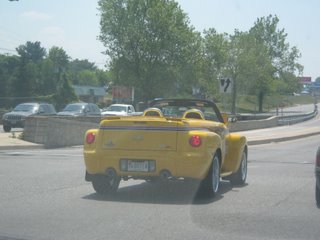
I don't know what the hell this is or was, but it's made by Chevy, has an SS badge and looked pretty cool, so I got a photo of it. This however, isn't the most ostentatious car we've seen so far. Stay tuned.

Believe it or not, that overbridge is just for some crappy little inter-county road. In Australia, they'd make you slog down into the valley and deal with a roundabout. Scrooges!

It's amazing what you can find just lying about on the side of the road. Seriously. This is apparently an M-60 Tank.

The business end.

Segregation is still alive and well, and living on Interstate 99. They probably want to frisk them for hubcaps.

I think when he parks this car, his tyres are in two separate counties. Wasn't that fast though - he was overtaken about 10 seconds later by an old man driving a Kia Rio, so yeah.

I think this sign is intended to warn us that we're passing through Michael Moore territory. Or that we're on a single lane road with blind corners that might have some nonce on a motorbike come blasting out of his driveway into one and almost collect us if it wasn't for violent evasive action on our part that almost saw us hit his dumb arse anyway.
Probably the latter.

Yeah, this sign doesn't work. Well, it does, but not when the old man is involved. Considering he's looking in the rear mirror and counting two seconds to see if the car behind him is too close. Woe betide the driver who gets within our back bumper before the old man has counted "one thousand and one, one thousand and tw-HE'S TOO DAMN CLOSE!"
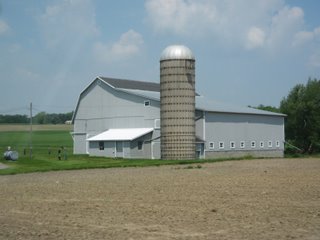
A fairly standard barn here in the states, complete with phallic grain silo.

A reasonably picturesque part of upstate New York.
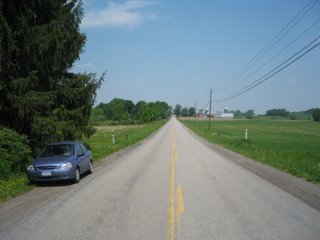
The mighty Kia, parked alongside a rural backdrop.

A typical American village. Seriously, communities like this are everywhere. It's not like Australia, where you could drive for an hour in the outback and not see a house, or another car. The whole country is settled. It's a completely different place.
You might have noticed I had a fair bit of time to photograph stuff both from inside and outside of the car whilst driving through these rural areas. How is this possible you ask? Easy.

Get stuck behind one of these bastards.
Ok, well now for the main event - Niagara Falls. It's huge, it's phenomenal, and it's coming right up!
After this pizza break. Here you go Laurie. As promised.

Right, now that's been sorted...

This is American Falls. Niagara Falls is essentially composed of three different waterfalls. Horseshoe Falls, which is hidden in the distance behind the huge cloud of mist and waterspray, is the largest. 90% of the water that passes through Niagara Falls goes over Horseshoe Falls. The remaining 10% goes over American Falls, which you can see front and center here, as well as Bridal Veil falls, which is a tiny waterfall in between the two giants.

This shows American Falls, and Bridal Veil falls, which is just to the right of American Falls in this picture, separated by a small rocky outcrop. The boat in front is one of the Maidens of the Mist, which sail right into the waterfalls, almost disappearing in the froth and mist. Behind that is the Rainbow Bridge, connecting Canada (where I'm standing, and the US). As you can see, it gets the name Rainbow Bridge for obvious reasons.

This is Horseshoe Falls. It's difficult to get a good photo of this - the huge amount of spray tends to obscure the waterfall. Suffice to say, the waterfall is about 670 metres wide, and drops about 53 metres. Yeah, it's huge.

This is the Canadian side of Horseshoe Falls. They reckon 20 billion litres of water passes over this every hour. I worked out at that rate, if you could re-direct Niagara Falls into Lake Wivenhoe, you'd fill it up in 2 days. Not bad. How's those water restrictions going in Brisbane?
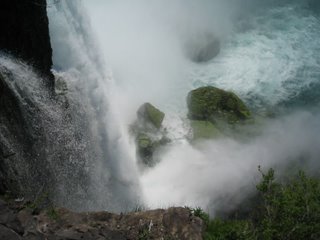
The view you'd have if you jumped over Horseshoe Falls. I'll pass. Although people do, and have gone over it in barrels and stuff. God knows how they survive.

Self-portrait yeah! Phil advised me to try and include some photos taken by me, of me - so while Dad was in the car, I snapped this one. Came out rather well, if I say so myself. Got the waterfall, the boat and the corner of the rainbow. Shame about the nob in front, but what can you do?

We saw this outside our motel. The steering wheel was made of linked chain for chrissake. Awesome.
Also, just to finish, stuff I forgot to include from previous days, aimed at certain people...
...Well, actually, only Craig. Still. I found this on Antietam battlefield, thought you'd appreciate it. Good Catholic boys, all of 'em.
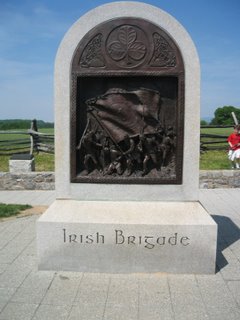
Well, the plan is tomorrow - get the hell out of Canada. I'll try and get some shots of Toronto, apparently they have some huge arse tower in the city or whatever, so should make good pixellated eye candy. That is of course, unless we meet an untimely end on this pathetic excuse for a freeway. Should be interesting.
